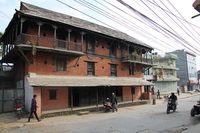

Did you know that there are dozens of temples in Pokhara?Very few people explore Pokhara beyond the popular Lakeside area. It’s not hard to imagine why either as very little “old” culture is ever promoted there. An unfortunate result of big resort hotels and adventure activities outshining the past. Back in the mid 17th century Pokhara was no more than a minor trading route linking to Tibet. However after the Malla kings finished a road linking the town with the Kathmandu Valley it flourished. Newar traders from the prosperous valley set up in Pokhara and the town took off economically. With the Newar culture came the distinct Newari style of architecture and design. Where are all the Newari buildings and temples in Pokhara?Most are only a short 40 minute walk from lakeside in the “new” part of Pokhara which is actually its oldest part. Most of the older buildings are hidden between streets of modern concrete buildings and rubble.  Along lakeside itself many of the temples and shrines are relatively new. The most impressive is the Kedareshwar Mahadev Mani temple in Friendship park (see my Pokhara guidebook for details). This is a very new temple to Shiva which was built over an older shrine. The most famous temple is the Barai temple just off the shore to Phewa lake. After you battle the boating touts (details on how to avoid them are included in my guidebook) you reach the little island temple which is said to hold the origins of the lake in its history. After that there are only a couple of small shrines along the main road and a small cluster of Shiva shrines near the Waterfront resort turn off. To reach the really old temples you’ll need to head out to the end of New Road or out along the main highway to Kathmandu. It’s all walkable within a morning. Pokhara’s Old Newari BazaarAt the top of New Road take a left. Then follow the road to the end and take the next right onto Ram Krishna Tole. Walk on up the inclining road lined with concrete stores and houses.  Slowly over a period of 10 minutes you’ll notice some of the buildings feigning a resemblance to Kathmandu’s old city. You’ll pass a few shrines and then a larger new Ganesh temple in the middle of the road. Right at the temple you’ll notice to your left a line of old crumbling brick buildings straight out of Kathmandu – Welcome to the “old bazaar”. 300 years ago this area was the center of commerce for 200+ years in Pokhara. It was the main trading and commercial zone. Linking both Tibet and Kathmandu. It was where all the produce was brought to be sold. Linens from the south and north were traded. Spices from India merged with spices from Tibet in this little known spice route of Nepal. Crumbling buildings of history in PokharaNo matter what day of the week you visit there’s a feeling like you arrived on the wrong day. Everything looks closed up as if everyone is having a rest day. The reality is the traders have long since gone. Once the Malla’s left and the Rana’s came before the Shah’s and Nepal united the desire for big commerce overtook the love of culture.  Most of the commercial sector moved south to the main roads adjacent to New Road. Old historical buildings were left behind for bland concrete buildings on wider roads. The few remaining traders stood little chance.
The old bazaar largely closed up. Trading houses became homes which were subdivided into apartments. There was a sudden rush to demolish the old buildings and build new concrete homes instead. Within in the space of 50 years most of the historic bazaar was gone. Development and corruption was too much for the historic quarterTalking with the few remaining families in the area I learned of a brief and official government initiative to save the old bazaar. Residents were told they could not demolish the old buildings but had to preserve them instead. Not a bad idea aside from the fact that the government offered little or no funding.  House owners either continued unabated in their replacement of the old buildings or simply left the old ones crumble to pieces until they literally fell to the ground in neglect. Unrepairable they were then replaced with cheap concrete and brick housing. A chance to watch history crumble awayAfter the 2015 earthquake I visited the old bazaar. Though there was very little damage caused in Pokhara these old badly maintained buildings were hit. You can now see cracks quite easily in the masonry. Some mysteriously “fell” to the ground shortly after the earthquake. Now deemed to be a potential danger to the community. Personally I don’t believe the old bazaar will be around much longer. This original trading settlement that brought so much to Pokhara will soon vanish. Replaced by bland modern housing. Given the lackluster approach to rebuilding the temples in the Kathmandu Valley I don’t foresee much help for preserving Pokhara’s last remains of historical culture.  It could be so easily done though. As many of the buildings are soon to be beyond repair then surely any new construction could be mandated to resemble traditional builds rather than modern bland designs. The problem is there is no desire for this within the local community. It’s all about the “new”. Perhaps in a century, if and when the country develops, future generations will regret this loss of their history. The good news is that I am pleased to report that the Digital Archaeology Foundation has preserved much of this areas temples in digital format. The one remaining tantric templeAs you walk further up the old bazaar you’ll surely come across the tantric Bhimsen temple standing resolute in the middle of the road. This 18th century temple is the oldest Newari style temple of its kind in Pokhara.  The two-tiered temple is dedicated to Bhimsen, the god of trade and commerce. As you can relate it was the most important in this area given its history as a trading area. The good news here is that the temple is in excellent condition. As it’s the only one of its kind in Pokhara the local community maintains it quite well. The biggest immediate danger to it is from vehicles along the road where it stands. Someone has wisely put a concrete pillar to one side to prevent a direct collision. Perhaps another one on the other side would double the protection from rampant drivers at night. Walking from the past to the presentAs you continue walking through the old bazaar the buildings become a mix of old, present and new. You’ll pass come cobblers, butchers and the odd vegetable seller. All local and of no real note. You’ll then reach a small fenced in area with a ganesh shrine. This is technically the end of the old bazaar. Continue walking north and you’ll get to to Pokhara’s most “famous” temple for visitors, the Bindrabisini temple, which stands at the top of a small hillock above a monastery.  It too is from the 17th century. Though you might not think that these days. A decorative concrete wall is currently being constructed around the small central shrine. More temples in PokharaThere are even more temples dotted around Pokhara. Just walk down the way you came along the old bazaar and keep heading south along the quiet tree lined road and you’ll come across several temples including an 18th century Ganesh temple. Further off along the Kathmandu highway and you’ll come across the quaint Badrakali Temple atop a green hill. This small temple has claims to being Pokhara’s oldest. With mountain views on a clear day it’s certainly idyllic though not particularly “old” looking.  For me, it’s the old bazaar that I enjoy most in Pokhara. It’s nothing spectacular. Most locals will dismiss any interest in it at all and wonder why you would ever want to visit. However if you have any interest in Nepal’s history or seeing the non-touristy side to Pokhara then it certainly makes for an interesting morning walk. It’s all free and in return you’ll get to witness what probably won’t be here in 20 years. Though maybe, just maybe if someone see’s that tourists have an interest something may get done to preserve this little known part of Pokhara.
Get my Kathmandu Valley Guidebook to learn more about Nepal!The most up-to-date, popular and dedicated guidebook to the Kathmandu Valley in the world. Take a look below and you’ll find out why! |
| Find out more here! |

Need a hotel in Nepal?
I recommend you try my own hotel search for Nepal.
The best online rates guaranteed!


Nice read. Your in-depth side to Nepal is a breath of fresh air.
Thanks Tom
We visited the Barahi temple a few years ago. Our guide never even showed us or told us about this other side to Pokhara. I wonder why they don’t?
Good point. Probably because it’s aways from Lakeside where they can take tourists to their friends restaurants and souvenir stores. They also probably don’t know the history of the temples and have little interest in them – sadly.
History defines us, losing it is a crime.
Completely agree, sadly we are in the minority.
Something similar happened in Germany after the war. The buildings were razed rather than rebuilt and we know the consequences of that. Bland concrete that’s defined a generation.
That’s a good point Stephan. In the future it looks like most of Nepal is going to be bland at this rate.
Isn’t there a way to call it a heritage location? To protect it?
It’s not really worked in the rest of Nepal. But yes if it was designated a heritage zone there would be a lot more pressure to protect it. I believe this needs to be done by the local authority.
I never knew this side to Pokhara, thanks for telling me about it. I hope others get to see it.
So do I!
I only thought Kathmandu had temples. I’m learning so much here. Thank you!
There are temples spread out all over Nepal. However many are simply no more than a little shrine. The beautiful temples are slowly disappearing.
Such a same so many people don’t care about their past when it comes to preservation. Thank for showing what might be the last photos of these beautiful buildings.
It is indeed sad to know these might well be the last photographs of this area.